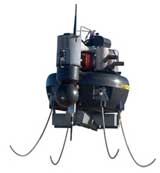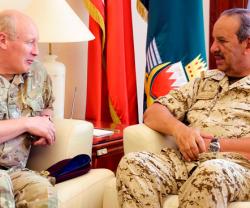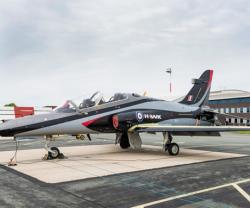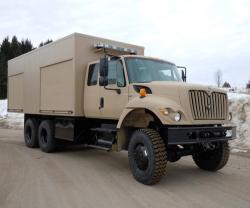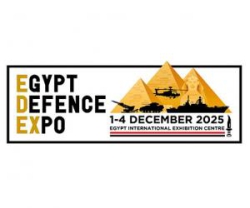Honeywell T-Hawks in Fukushima Disaster Recovery
25.04.2011 Asia
Honeywell’s T-Hawk Micro Air Vehicle (MAV) is helping emergency workers at Japan’s Fukushima Daiichi nuclear facility get up-close video and photos inside the plant as they work to limit further radiation releases.
3 Honeywell employees, trained to fly the unmanned T-Hawks remotely, have flown 5 successful missions and captured hours of video and dozens of photos of the nuclear reactor. The 4 T-Hawks in service at Fukushima Daiichi have been adapted to carry radiation sensors.
“On behalf of all of us at Honeywell, our hearts go out to the people of Japan, particularly those who have suffered as a result of the earthquake and tsunami that damaged the Fukushima Daiichi nuclear plant and surrounding areas,” said Tim Mahoney, President and Chief Executive Officer of Honeywell Aerospace. “At Honeywell, we are proud of our commitment to safety and security, and we are grateful that our technologies can be deployed now to help the people of Japan in this historic time of need.”
Currently deployed in war zones in Iraq and Afghanistan, the T-Hawk features unique hover-and-stare capability that enables pilots to hold it in one place and zoom in on features inside the damaged reactors while the T-Hawk sends live video and still images back to recovery workers. The T-Hawk also is capable of sending live in-flight video feeds to help workers focus on critical areas and adjust direction mid-flight. Pilots can control T-Hawk cameras to alter angles and get better views of damaged equipment. Just 14 inches in diameter, the T-Hawk can be flown into tight spaces where humans and other aircraft cannot go.
“The T-Hawk reminds us that innovative technologies initially created for defense purposes can find crucial roles in humanitarian and disaster recovery efforts,” Mahoney said.
Weighing just 17 pounds, the T-Hawk is a ducted-fan vertical takeoff and landing air vehicle originally designed in conjunction with a Defense Advanced Research Projects Agency (DARPA) Advanced Concept Technology Demonstration (ACTD) program. Pilots can determine manual or autonomous flight paths from up to six miles away for up to 40 minutes at a time.
The T-Hawk is a proven force multiplier in Afghanistan and Iraq, where systems have been averaging more than six hours of flight time a day. The T-Hawk is used in Afghanistan for route clearance, infantry assault, and explosive ordnance disposal missions, where, together with its similar work in Iraq, it has cumulatively flown more than 17,000 hours. The United Kingdom’s Ministry of Defense also deploys the T-Hawk for combat missions in Afghanistan and trains with the T-Hawk in Afghanistan and Jordan. The T-Hawk is currently being tested for urban use by the Miami-Dade Police Department.
3 Honeywell employees, trained to fly the unmanned T-Hawks remotely, have flown 5 successful missions and captured hours of video and dozens of photos of the nuclear reactor. The 4 T-Hawks in service at Fukushima Daiichi have been adapted to carry radiation sensors.
“On behalf of all of us at Honeywell, our hearts go out to the people of Japan, particularly those who have suffered as a result of the earthquake and tsunami that damaged the Fukushima Daiichi nuclear plant and surrounding areas,” said Tim Mahoney, President and Chief Executive Officer of Honeywell Aerospace. “At Honeywell, we are proud of our commitment to safety and security, and we are grateful that our technologies can be deployed now to help the people of Japan in this historic time of need.”
Currently deployed in war zones in Iraq and Afghanistan, the T-Hawk features unique hover-and-stare capability that enables pilots to hold it in one place and zoom in on features inside the damaged reactors while the T-Hawk sends live video and still images back to recovery workers. The T-Hawk also is capable of sending live in-flight video feeds to help workers focus on critical areas and adjust direction mid-flight. Pilots can control T-Hawk cameras to alter angles and get better views of damaged equipment. Just 14 inches in diameter, the T-Hawk can be flown into tight spaces where humans and other aircraft cannot go.
“The T-Hawk reminds us that innovative technologies initially created for defense purposes can find crucial roles in humanitarian and disaster recovery efforts,” Mahoney said.
Weighing just 17 pounds, the T-Hawk is a ducted-fan vertical takeoff and landing air vehicle originally designed in conjunction with a Defense Advanced Research Projects Agency (DARPA) Advanced Concept Technology Demonstration (ACTD) program. Pilots can determine manual or autonomous flight paths from up to six miles away for up to 40 minutes at a time.
The T-Hawk is a proven force multiplier in Afghanistan and Iraq, where systems have been averaging more than six hours of flight time a day. The T-Hawk is used in Afghanistan for route clearance, infantry assault, and explosive ordnance disposal missions, where, together with its similar work in Iraq, it has cumulatively flown more than 17,000 hours. The United Kingdom’s Ministry of Defense also deploys the T-Hawk for combat missions in Afghanistan and trains with the T-Hawk in Afghanistan and Jordan. The T-Hawk is currently being tested for urban use by the Miami-Dade Police Department.
Previous PostAlenia Aeronautica Delivers 3rd C-27J to Bulgaria
Latest news
Latest events
Egypt Defence Expo (EDEX)
01 - 04 Dec 2025Egypt International Exhibition Center New Cairo - EgyptDoha International Maritime Defence Exhibition & Conference (DIMDEX 2026)
19 - 22 Jan 2026Doha - QatarUMEX – SimTEX
20 - 22 Jan 2026ADNEC Centre Abu Dhabi, - United Arab EmiratesWorld Defense Show (WDS) 2026
08 - 12 Feb 2026Riyadh - Saudi Arabia

